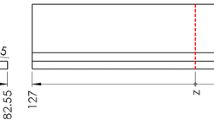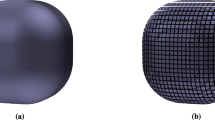Abstract
Background: While the contour method for residual stress assessment has developed rapidly, no published study documents its interlaboratory reproducibility. Objective: Here we report an initial reproducibility experiment focused on contour method data analysis and residual stress calculation. Methods: The experiment uses surface topography data from a physical process simulation of elastic-plastic beam bending. The simulation provides surface topography, for input to the contour method data analysis, as well as a known residual stress field with 130 MPa peak magnitude. To increase realism, noise and specific artifacts are added to the topography data. A group of participants received the topography data (without the known residual stress), independently analyzed the data, and submitted results as a two-dimensional residual stress field. Results: Analysis of submissions provides a group average residual stress field and the spatial distribution of reproducibility standard deviation. The group average residual stress agrees with the known stress in magnitude and spatial trend. The reproducibility standard deviation ranges from 2 to 54 MPa over the measurement plane, with an average of 5.4 MPa. Reproducibility standard deviation is smaller in the cross-section interior (≤ 5 MPa), modest near local extrema in the stress field (5 to 10 MPa), and larger near the cross-section boundaries (10 to 30 MPa). The largest values of reproducibility standard deviation (up to 54 MPa) occur in limited areas where artifacts had been added to the topography data; while some participants identified and removed these artifacts, some did not, leading to systematic differences that elevated the standard deviation.












Similar content being viewed by others
Change history
17 June 2020
The original version of this article has been corrected to include authors middle initials in the author list. The details given in this correction are correct.
References
Prime MB (2001) Cross-Sectional Mapping of Residual Stresses by Measuring the Surface Contour after a Cut. J. Eng. Mater. Tech 123:162–168
Hill MR, Olson MD (2014) Repeatability of the contour method for residual stress measurement. Exp Mech 54(7):1269–1277
Olson MD, DeWald AT, Prime MB, Hill MR (2014) Estimation of uncertainty for contour method residual stress measurements. Exp Mech 55(3):577–585
ASTM E691-15, Standard Practice for Conducting an Interlaboratory Study to Determine the Precision of a Test Method (2015) ASTM international. West Conshohocken, MA
Hosseinzadeh F, Kowal J, Bourchard PJ (2014) Towards good practice guidelines for the contour method of residual stress measurement. J Eng 8:453–468
Prime MB, DeWald AT (2013) The Contour Method. In: Schajer GS (ed) Practical Residual Stress Measurement Methods. Wiley, West Sussex
Prime MB, Gonzales AR (2000) Contour Method: Simple 2-D Mapping of Residual Stresses. In: Proceedings of the 6thInternational Conference on Residual Stresses. IOM Communications, London, pp 617–624
Dassault Systèmes Simulia Corp., ABAQUS Analysis User's Guide version 6.14, Providence, RI, USA, 2014
Metallic Materials Properties Development and Standardization (MMPDS): MMPDS-06. United States Federal Aviation Administration, Washington D.C., 2011
Franchi A, Riva P, Genna F (1991) Incremental elastic-Ziegler kinematic hardening plasticity formulations and an algorithm for the numerical integration with an "a priori" error control. In: Grierson DE et al (eds) Progress in Structural Engineering, pp 407–421
Dassault Systèmes Simulia Corp., ABAQUS Analysis User's Guide version 6.14, section 23.2.2, Models for metals subjected to cyclic loading, Providence, RI, USA, 2014
Olson MD, DeWald AT, Hill MR (2018) Validation of a contour method single-measurement uncertainty estimator. Exp Mech 58:767–781. https://doi.org/10.1007/s11340-018-0385-4
Olson MD, DeWald AT, Hill MR (2018) Repeatability of contour method residual stress measurements for a range of materials, processes, and geometries. Materials Performance and Characterization 7(4):427–445. https://doi.org/10.1520/MPC20170044
Funding
This study was performed by the authors without the support of external funding.
Author information
Authors and Affiliations
Corresponding author
Ethics declarations
Conflict of Interest
• SSC, MLS, TJS, and JBL report no potential conflicts of interest.
• CRD is a graduate student pursuing a doctorate under the guidance of MRH.
• MBP holds patent US6470756B1 on the contour method, from which modest royalties are received.
• JAO and MRH have separate economic interests in contour method measurements that derive from their employment by (JAO) or an ownership interest in (MRH, Hill Engineering, LLC of Rancho Cordova, CA, USA) a firm providing contour method measurements.
All authors affirm that these potential conflicts of interest did not play a significant role in the work reported here and that this paper reflects the consensus of all authors.
Additional information
Publisher’s Note
Springer Nature remains neutral with regard to jurisdictional claims in published maps and institutional affiliations.
The original version of this article has been corrected to include authors middle initials in the author list. The details given in this correction are correct
Rights and permissions
About this article
Cite this article
D’Elia, C.R., Carlson, S.S., Stanfield, M.L. et al. Interlaboratory Reproducibility of Contour Method Data Analysis and Residual Stress Calculation. Exp Mech 60, 833–845 (2020). https://doi.org/10.1007/s11340-020-00599-0
Received:
Accepted:
Published:
Issue Date:
DOI: https://doi.org/10.1007/s11340-020-00599-0




